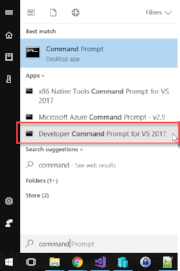Adding a map to Webdrawer
My out-of-the-box webdrawer interface lacks a map for the results! Here's what it looks like right now....
Let's fix it!
If I open the results list partial class file in the "/Views/Shared" directory, I can partition the page into two columns.
<table id="container" margin="5"> <thead> <tr> <td width="50%"><span style="margin-left:10px">Results List</span></td> <td width="50%">Results Map</td> </tr> </thead> <tbody> <td id="listColumn"> <!-- Search Results go here --> </td> <td id="mapColumn"><div id="mapDiv"></div></td> </tbody> </table>
Next we import the google maps API
<script type="text/javascript" src="https://maps.googleapis.com/maps/api/js?key=123"> </script>
But I also need to add some code that results in the map being loaded...
<script type="text/javascript"> var map; var markers = []; var mapmarkers = []; function initialize() { var mapOptions = { center: new google.maps.LatLng(27.897349,-82.155762), zoom: 7, disableDefaultUI: true, zoomControl: true, panControl: true, mapTypeControl: true, scaleControl: true, streetViewControl: true, rotateControl: true, overviewMapControl: true }; map = new google.maps.Map(document.getElementById("mapDiv"), mapOptions); addMarkers(map); } google.maps.event.addDomListener(window, "load", initialize); </script>
This gives me my desired user interface!
Next I need to have Webdrawer "addMarker" for each record in the results set. I decided to do this at the very bottom of the results list file, but only if there are records. And then only for those having a GPS location.
if (Model.Results.Count > 0) { <script type="text/javascript"> @foreach (TrimObject record in Model.Results) { var gpsloc = record.GetPropertyOrFieldString("RecordGpsLocation"); if ( !String.IsNullOrWhiteSpace(gpsloc) ) { @Html.Raw("addMarker('" + record.GetPropertyOrFieldString("RecordNumber") + "','" + gpsloc + "');"); } } </script> }
So now I've got the page calling "addMarker" for each record in the search results. I need to store each one in memory by pushing it into the array of markers. I also need to define the addMarkers method called by the initialize function during page load. In that method I iterate each of the array elements, create a marker on the map, and store that marker reference for later manipulation.
<script> function addMarker(rnum, ltlg) { var marker = { "rnum": rnum, "ltlg": ltlg }; markers.push(marker); } function addMarkers(map) { for (i = 0; i < markers.length; i++) { var marker = markers[i]; if (marker.ltlg.indexOf('POINT(') >= 0) { var ltlg = marker.ltlg.replace('POINT(', '').replace(')', '').split(' '); var mapmarker = new google.maps.Marker({ position: new google.maps.LatLng(ltlg[1], ltlg[0]), map: map, title: marker.rnum }); mapmarkers.push(mapmarker); } } } </script>
Now if I refresh my results window I can see records plotted on the map. Success!
Whoops.... it's becoming clear that my data import is messed up. It's including locations beyond my desired regional boundary. I should only be importing Florida facilities! That issue will be tabled for now.

























